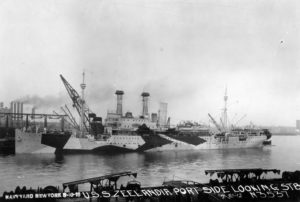
The Zeelandia was a passenger ship converted for use as a troop transport by the United States Navy during World War I. My granduncle Russell T. Stewart sailed on the USS Zeelandia on her first voyage to France in 1918. While researching his experiences, I discovered some interesting facts about this ship.
Shown here at New York harbor on May 10, 1918, the ship had been newly outfitted. She sports a new coat of paint known as dazzle camouflage, also called razzle dazzle. Rather than conceal the ship, it was intended to make it difficult for enemy submarines to determine the ship’s range and speed.
The Zeelandia was a Dutch commercial passenger ship named after Zeeland, the westernmost province of the Netherlands. She was built in 1910 in Scotland, and owned and operated by Koninklijke Hollandsche Lloyd (Royal Holland Lloyd) based in Amsterdam. How she became a US Navy transport is interesting.
Her Detainment
In September 1917 she sailed from Buenos Aires bound for the Netherlands. But, she carried a US naval officer, and other passengers and mail bound for New York along the way. Although she had enough fuel and provisions to continue her voyage to the Netherlands, the captain was assured he could enter the port of New York, as long as he didn’t take on any additional cargo. During the war, the Espionage Act and the Trading with the Enemy Act required approval of all US goods shipped to Europe, to keep them from falling into enemy hands.
However the captain wanted to take on some stranded Dutch citizens and therefore some additional stores just for their travel on the remaining leg of the voyage. This caused a delay waiting for approval. Frustrated after several days waiting, the captain canceled his request. He wanted to set sail with just his original cargo, which should have required no approval. However US officials refused to grant the ship clearance. And, they continued to do so for several months, all the way until March 21, 1918.1
It was about then the Navy chartered the Zeelandia to commission her as a naval transport. Presumably Royal Holland Lloyd or the Dutch government was compensated for that charter. The Zeelandia had been detained without cause for several months, ostensibly to prevent her from falling into enemy hands, or perhaps with secret intention for her eventual use as a US transport.
Well after the war, in 1932 Royal Holland Lloyd won judgment against the United States for damages from those months being detained at New York harbor. Losses included the market value for use of the ship, and the cost of fuel, wages, repairs, port expenses, water, and insurance, all with interest. The Dutch were awarded over a half million dollars. The litigation continued though. In 1936, the Dutch sued the Internal Revenue Service, which tried to tax the money awarded in the previous case. That case also found for plaintiff, that the money was not taxable.2
Here is the Zeelandia at New York, probably during her detainment in early 1918. A large colorful Dutch flag is painted on her bow as a symbol of neutrality while sailing to and from Europe.3

On May 6, 1918, Rear Admiral David W. Taylor reported that arrangements for conversion of the Zeelandia were already made.4 Clearly, several photographs of the Zeelandia taken May 10, 1918 show she had been, or was nearly, complete.5 The following photos were taken only eight days prior to her first voyage as a US Navy transport. During that time, she must have sailed from Pier 97 at New York to Newport News, Virginia, where my granduncle Russell Stewart boarded at midnight May 17, 1918.6
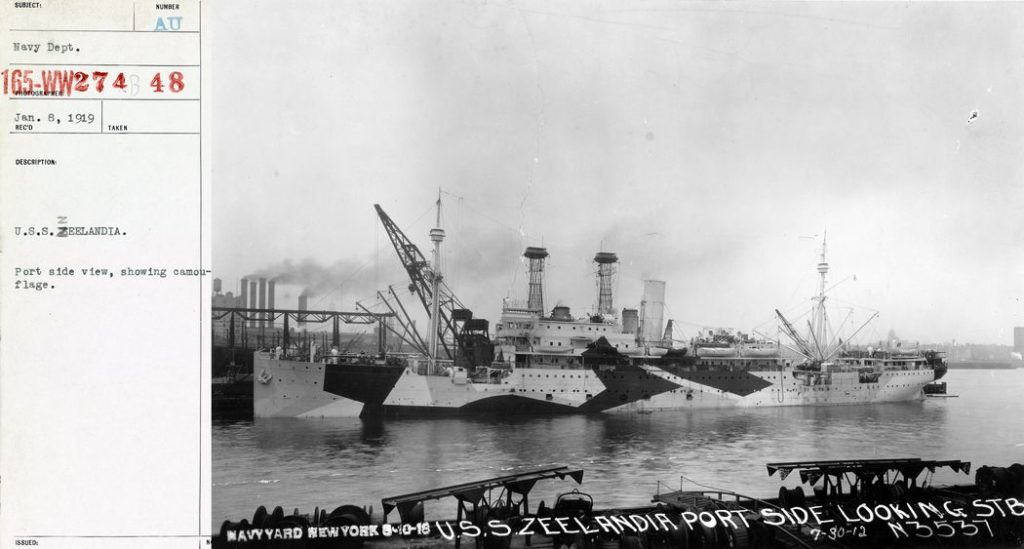
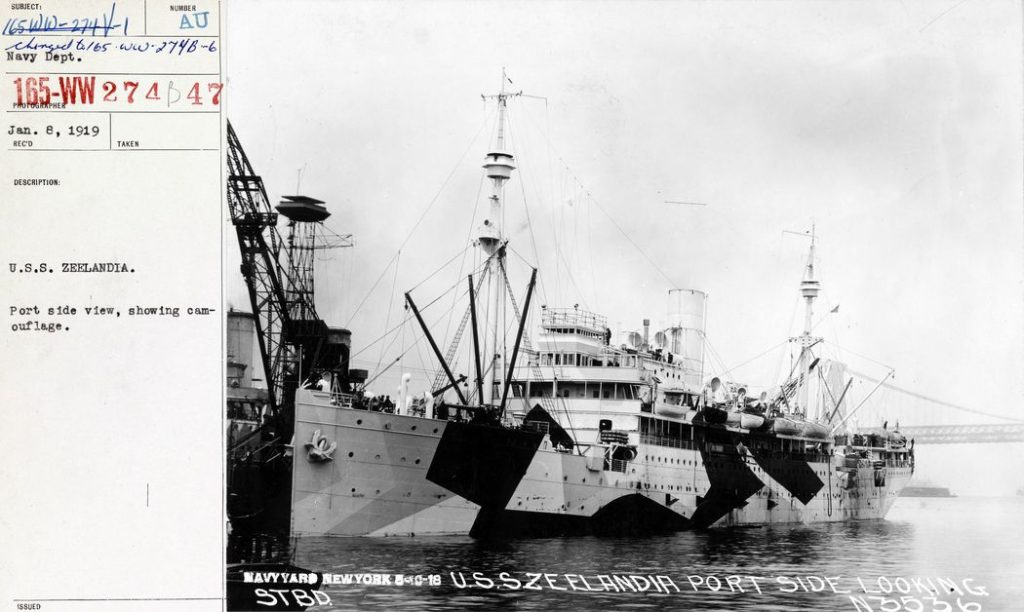
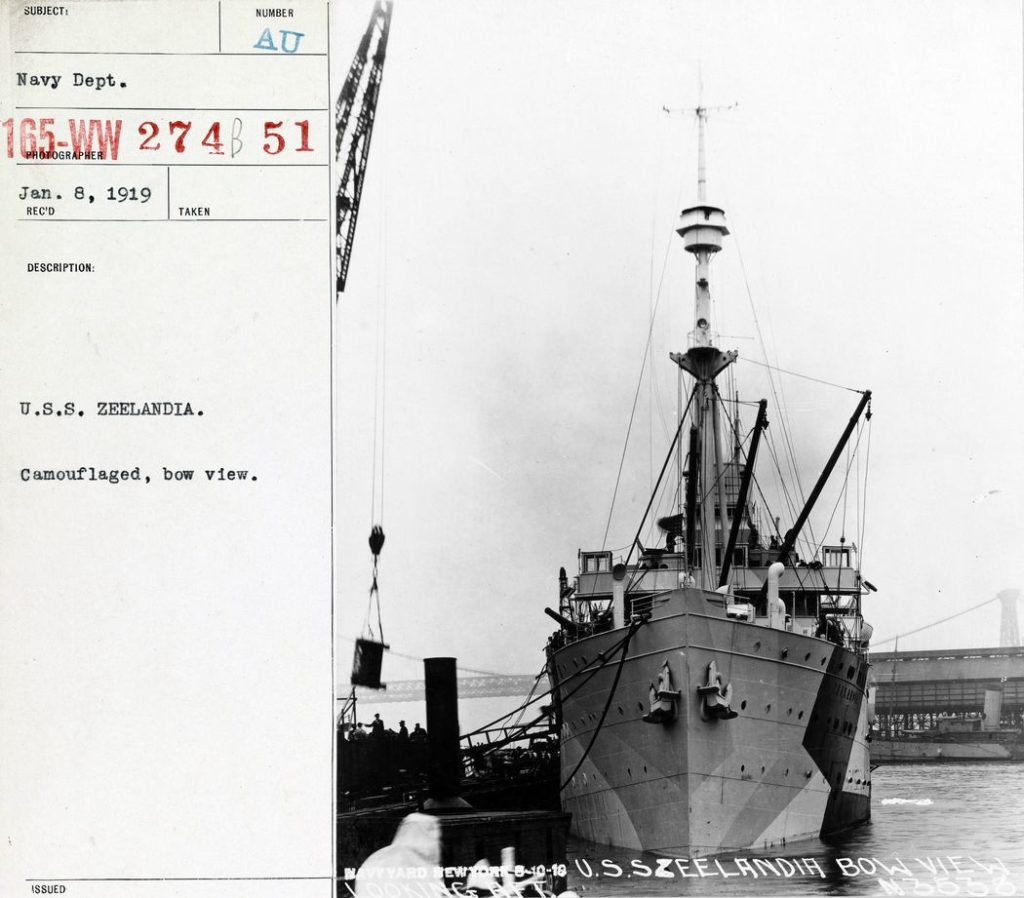
Her First Voyage
The entire 80th Division, all 26,851 men, sailed on 12 different ships over 5 different days mainly from May 17 through May 26. As part of the 80th Division, the 319th Infantry required three ships, the Madawaska, the Duca d’Abruzzi, and the Zeelandia.7 Russell Stewart, in Company M, was assigned to the Zeelandia. There were altogether 255 men in Company M. He is listed in this excerpt from the ship’s manifest.8
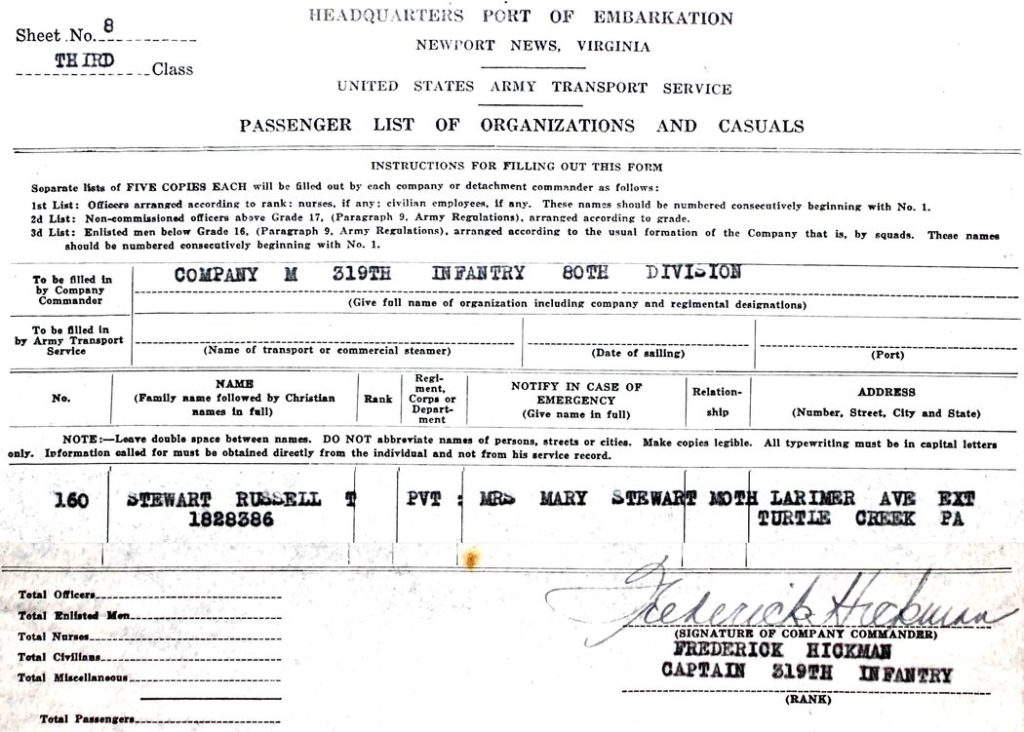
US Navy Commander Robert Henderson commanded the Zeelandia, which sailed May 18, 1918 from Newport News, Virginia on her first voyage as a converted troop transport. There were fifteen ships and one cruiser in the convoy. 9
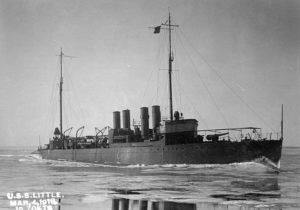
There was also at least one destroyer. Commander Joseph K. Taussig commanded the Navy destroyer USS Little (DD-79/APD-4). He noted in his diary that his ship shoved off May 18, 1918 at 11:00 am.10 Just before reaching the rendezvous point, a thick fog set it, and word was received the President Grant had run aground in the channel. It was expected to come off at high tide, but all ships in the convoy had to wait for her. Because of continued fog, the Little set anchor at 7:00 pm. By 11:00 pm the fog lifted and the convoy got underway. The fog returned, but since they were underway, they continued onward using fog horns.
When the fog lifted after daylight, Commander Taussig found he was with the Madawaska, Duc d’Abruzzi and Bridge on one side and the Pocohontas and Zeelandia on the other. Other ships were not in sight, but they soon caught up with them before dark, except, the Re d’Italia was apparently further ahead.
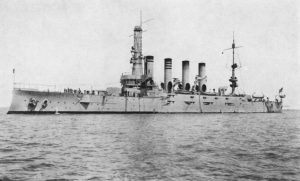
The convoy maintained 12-1/2 knots since that was the maximum speed of the President Grant. She was the largest ship, with 4,600 troops aboard. They immediately began sailing a zig-zag pattern due to reports of German U-boats in the area. They sailed in a double line of transports behind a Navy cruiser, the USS Huntington (ACR-5).
On some days a destroyer would steam past the transports at about a half mile distance towing a target that looked like a submarine periscope. The sailors on each transport would in turn practice firing the ship’s guns at this target.
Abandon ship drills were conducted daily. On May 22nd the Zeelandia’s whistle let out several deep blasts signaling “man overboard.” During a drill, one of the sailors fell into the sea because the lifeboat release mechanism broke on one side. A cruiser was able to turn around to rescue him, which took two hours.
Originally a commercial passenger ship, the Zeelandia was outfitted with four 6-inch guns, two 1-pounders, and two machine guns.11 Two aft 6-inch guns are shown in this view.
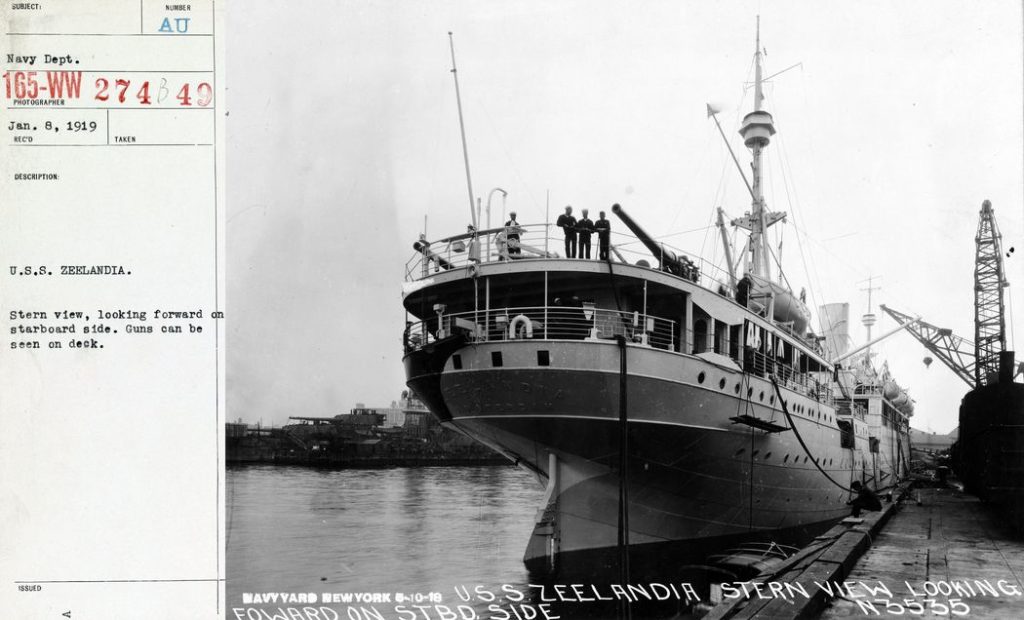
On May 26th a destroyer fired its guns and dropped depth charges at the sight of a submarine. All ships then went full-steam ahead with guns blazing for several minutes. However it turned out to be an overturned boat, not a submarine. Or, maybe, it was.
The cruiser USS Huntington sailed only part of the way and turned back on May 28th as they neared France. At the same time ten destroyers joined the convoy to guide it through the enemy U-boat zone.
Two days later on May 30th as the convoy neared France, three French airplanes flew out to escort the convoy to port. Just then the general quarters alarm sounded. The destroyers steamed back and forth dropping depth-charges. A submarine was spotted from the Zeelandia and the ship’s gunners fired at it as rapidly as they could. After several minutes it was gone and firing ceased. Recall sounded and everyone relaxed and started going back below deck.
Suddenly all four of Zeelandia’s six-inch guns were firing. There were several U-boats this time, and one was trailing the Zeelandia, which immediately began a zig-zag course. The forward guns then had to fire almost parallel down the length of the ship. The troops still on deck were forced to lay flat and hug the deck. The concussion of the passing shells broke windows and upset chairs on deck.
Reports indicated there were up to seven enemy U-boats that attacked. The enemy fired several torpedoes, but no ships in the convoy were hit.12
After twelve days at sea the Zeelandia arrived safely outside Saint-Nazaire, France on May 30, 1918 at 9:30 pm and set anchor. The next morning she came into port, to berth 15, at 11:00 am and immediately began unloading. It took a few hours for the 1,755 troops to disembark, but two days to unload all their belongings and cargo, until June 2 at 11:30 am. Company M alone had 20,800 pounds of barrack bags and crates. Troops reported to Rest Camp 1 near Saint-Nazaire.
The Zeelandia was delayed seven more days for unspecified repairs to machinery. She sailed June 8, 1918 for her return trip to the United States. She had several sick patients, that included six officers, two nurses, and forty-two soldiers. She also had three civilian passengers and two prisoners.13
Meanwhile on June 4th Russell Stewart was promoted from Private to Private First Class. That was also the day the 319th Infantry started their move inland. They entrained at 6:30 pm aboard cramped “40 hommes/8 chevaux” rail cars. These light “40 and 8” cars could carry 40 men or 8 horses. After more than a month of traveling by different trains and frequently marching, they arrived on July 22, 1918 in the British sector for further training with the British 2nd Division.
Military Cargo
The Zeelandia continued her voyages carrying troops and cargo. Here she is at the port of Brest, France unloading cargo on October 27, 1918.14 The ship had lost its original luster from months of heavy use. This was at the height of the Meuse-Argonne Offensive. Russell Stewart was camped near Lachalade that day preparing for the final phase of battle, only six days before he was killed in action.
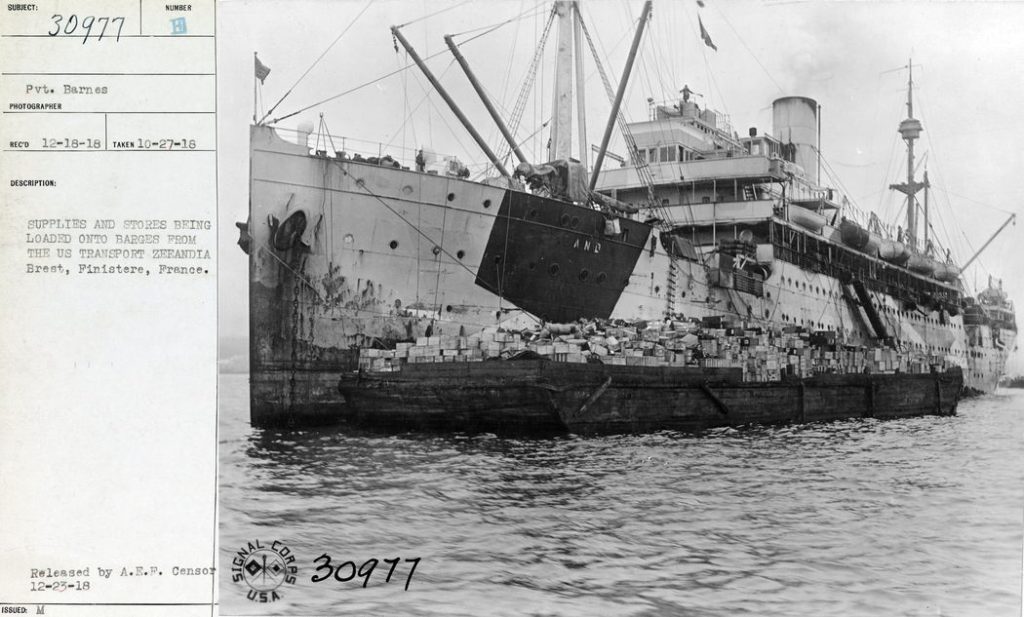
The above photo was taken simultaneously with a video.15 Here is an excerpt showing just the Zeelandia. The original video shows the labor-intensive process of unloading cargo onto lighters (non-powered barges), then unloading those barges at the wharf, then again loading trains for eventual delivery inland.
Repatriation
The Zeelandia reportedly made five round-trip voyages during the war, and then seven voyages afterwards. She transported 8,349 troops to France and later returned 15,737 troops back home.16 Pictured here are the officers of the USS Zeelandia in 1919.17
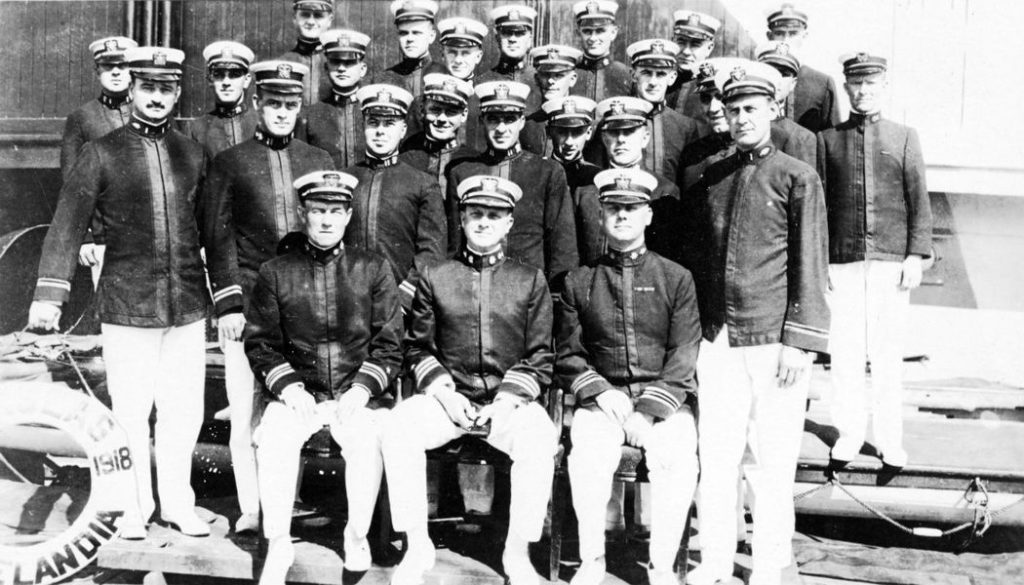
Here the Zeelandia returns home with troops standing on deck, sometime in 1919.18 By then the dazzle camouflage had faded almost completely.
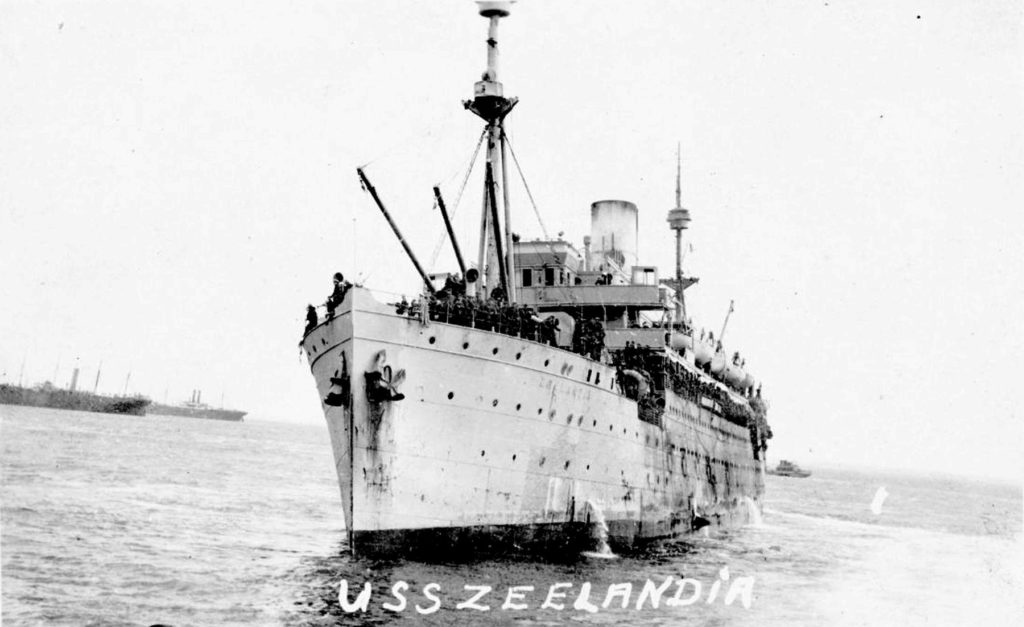
Here she is docked at Charleston, filled with troops anxiously waiting to see their families after a year at war.19 One of the six-inch guns is seen here on the port bow. By the way I don’t think they had enough lifeboats for everyone.

The Zeelandia was removed from Navy service by August 1919 and decommissioned by October 1919. She was returned to her previous owner at that time.20 She was scrapped seventeen years later, in April 1936. The Zeelandia played a vital part in our war effort even though she was obtained by dubious means. I can appreciate the experience of my granduncle, Russell T. Stewart, who sailed to France on her first voyage as a troop transport. Sadly, he did not return home.
Monument
American troops arrived for the first time in France at Saint-Nazaire on June 26, 1917. Thereafter nearly 200,000 troops came through the port. There is a special monument there dedicated to the American Doughboy. It was a gift of the American people to the people of France. The original statue was dedicated in 1926, but the Nazis destroyed it during World War II. A replica replacement was made and dedicated in 1989.
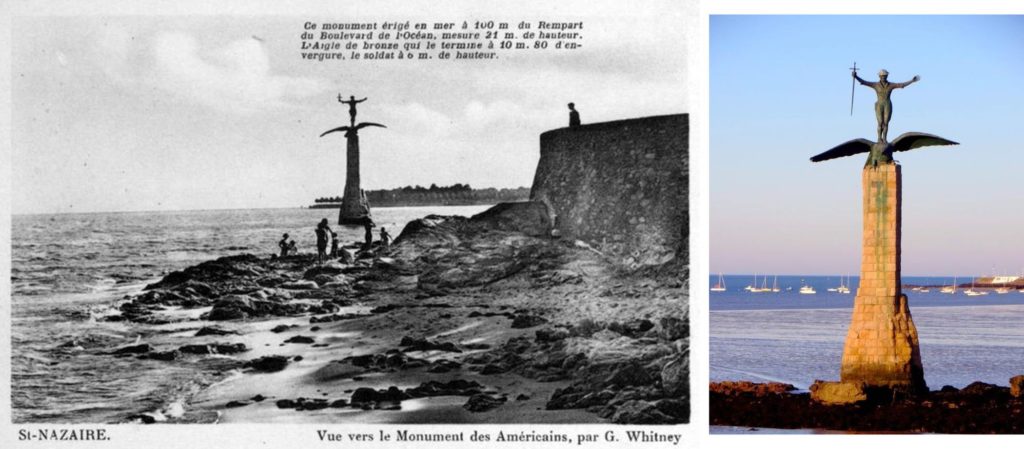
Affectionately known as the Saint-Nazaire “Sammy,” as in Uncle Sam, it’s what the French called American Doughboys during World War I. The Eagle, symbolizing America, gently lands on French soil and spreads her wings for protection. On top is an American Doughboy, knees slightly bent as if landing from a jump across the ocean. He holds a downward pointing sword, a symbol of peace.21
Footnotes- “Arbitration Between the United States and Sweden Under Special Agreement of December 17, 1930: The “Kronprins Gustaf Adolf” and the “Pacific” Oral Arguments, Washington, May 9 – June 2, 1932,” Volume 1, U.S. Government Printing Office, 1932, pages 38-41. Google Books (https://books.google.com/books?id=QVMSAAAAYAAJ&pg=RA1-PA39&lpg=RA1-PA38 : viewed 23 January 2020).
- United States. Board of Tax Appeals. “Reports of the United States Board of Tax Appeals,” Volume 34, “United States Board of Tax Appeals versus Koninklijke Hollandische Lloyd, (Royal Holland Lloyd), Petitioner, versus Commissioner of Internal Revenue, Respondent.” Docket number 78662, July 24, 1936, U.S. Government Printing Office, 1936. Google Books (https://books.google.com/books?id=ockpG95e-NUC&pg=RA113-PA1 : viewed 23 January 2020).
- United States Navy, NH 89784 S.S. Zeelandia, 1918-1919, Naval History and Heritage Command (https://www.history.navy.mil/content/history/nhhc/our-collections/photography/numerical-list-of-images/nhhc-series/nh-series/NH-89000/NH-89784.html : downloaded 25 January 2020).
- Rear Admiral David W. Taylor, “Dutch Ships Manned by Navy Department,” Naval History and Heritage Command (https://www.history.navy.mil/content/history/nhhc/research/publications/documentary-histories/wwi/may-1918/rear-admiral-david-w.html : viewed 25 January 2020), May 6, 1918.
- United States, War Department, 1789-9/18/1947, Record Group 165: Records of the War Department General and Special Staffs, 1860 – 1952, American Unofficial Collection of World War I Photographs, 1917 – 1918. National Archives Catalog (https://catalog.archives.gov/ : downloaded 16 Janunary 2020). To find an individual image, search for “165-WW-n”, where n is the photograph number. You may need to try different combinations of punctuation and spacing in the number to get a match.
- Charles Ryman Herr. Company F History, 319th Infantry: Pub. as a Matter of Record by the Officers and Men of the Company. Somerville, NJ: Unionist-Gazzette Association, 1920, page 16.
- Embarkation and Debarkation of the 80th Division, 1918-1919, “The Service Magazine,” Volume 8, Number 4, July 1927. 80th Division Veteran’s Association, (https://www.80thdivision.com/blueridge_wwi.html : viewed September 7, 2018), page 34.
- Lists of Incoming Passengers, 1917-1938; Lists of Outgoing Passengers, 1917-1938, microfilm publication (Washington, D.C.: National Archives and Records Administration), Record Group 92; Fold3 (https://fold3.com: downloaded 21 January 2020), Zeelandia, 18 May 1918, Russell T. Stewart, Company M, 319th Infantry, 80th Division, Sheet 8, Number 160.
- Charles Ryman Herr. Company F History, 319th Infantry: Pub. as a Matter of Record by the Officers and Men of the Company. Somerville, NJ: Unionist-Gazzette Association, 1920, page 16.
- Diary of Joseph K. Taussig, Commander, Little, Naval History and Heritage Command (https://www.history.navy.mil/content/history/nhhc/research/publications/documentary-histories/wwi/may-1918/diary-of-captain-jos-0.html : viewed 25 January 2020), Sunday, May 19, [1918] at sea.
- United States Navy, Zeelandia, #2507, 1918-1919, Naval History and Heritage Command (https://www.history.navy.mil/research/histories/ship-histories/danfs/z/zeelandia.html : viewed 23 January 2020).
- Events on the voyage are described in two different accounts. First, Josiah C. Peck, The 319th Infantry A.E.F. Paris: Clarke, 1919, pages 12-14. Second, Charles Ryman Herr. Company F History, 319th Infantry: Pub. as a Matter of Record by the Officers and Men of the Company. Somerville, NJ: Unionist-Gazzette Association, 1920, pages 15-18.
- The complete manifest and related ship’s paperwork can be viewed by paging backward and forward from Russell T. Stewart’s entry in the manifest. “Lists of Incoming Passengers, 1917-1938; Lists of Outgoing Passengers, 1917-1938,” microfilm publication (Washington, D.C.: National Archives and Records Administration), Record Group 92; Fold3 (https://fold3.com: downloaded 21 January 2020), Zeelandia, 18 May 1918, Russell T. Stewart, Company M, 319th Infantry, 80th Division, Sheet 8, Number 160.
- United States, War Department. Army War College. Historical Section. World War I Branch. ca. 1918-ca. 1948, Record Group 111: Records of the Office of the Chief Signal Officer, 1860 – 1985, National Archives Catalog. (https://catalog.archives.gov/ : downloaded November 11, 2018). To find an individual image, search for “111-SC-nnnnn”, where nnnnn is the photograph number.
- Department of Defense. Department of the Army. Historical Films, ca. 1914 – ca. 1936. Record Group 111: Records of the Office of the Chief Signal Officer, 1860 – 1985. Historical Film, No. 1341, produced 1936. National Archives Identifier: 24844. Local Identifier: 111-H-1341 (https://catalog.archives.gov/id/24844). YouTube (https://www.youtube.com/watch?v=CK_1Xe7iTKs : downloaded 23 January 2020).
- United States Navy, Zeelandia, #2507, 1918-1919, Naval History and Heritage Command (https://www.history.navy.mil/research/histories/ship-histories/danfs/z/zeelandia.html : viewed 23 January 2020).
- United States Navy, NH 107311 USS Zeelandia Ship’s officers, 1918-1919, Naval History and Heritage Command (https://www.history.navy.mil/content/history/nhhc/our-collections/photography/numerical-list-of-images/nhhc-series/nh-series/NH-107000/NH-107311.html : downloaded 25 January 2020).
- United States Navy, NH 106384 USS Zeelandia in a harbor, 1918-1919, Naval History and Heritage Command (https://www.history.navy.mil/content/history/nhhc/our-collections/photography/numerical-list-of-images/nhhc-series/nh-series/NH-106000/NH-106384.html : downloaded 25 January 2020).
- United States Navy, NH 103675 USS Zeelandia docked at Charleston, South Carolina, 1918-1919, Naval History and Heritage Command (https://www.history.navy.mil/content/history/nhhc/our-collections/photography/people—special-topics/african-americans-in-the-navy/african-americans-and-the-navy–wwi-to-wwii/uss-zeelandia-nh-103675.html : downloaded 25 January 2020).
- United States Navy, Zeelandia, #2507, 1918-1919, Naval History and Heritage Command (https://www.history.navy.mil/research/histories/ship-histories/danfs/z/zeelandia.html : viewed 23 January 2020).
- “Saint-Nazaire. 14-18. La véritable histoire du Sammy,” Ouest-France (https://www.ouest-france.fr/pays-de-la-loire/saint-nazaire-44600/saint-nazaire-14-18-la-veritable-histoire-du-sammy-6061696 : viewed 27 January 2020).

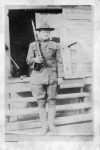
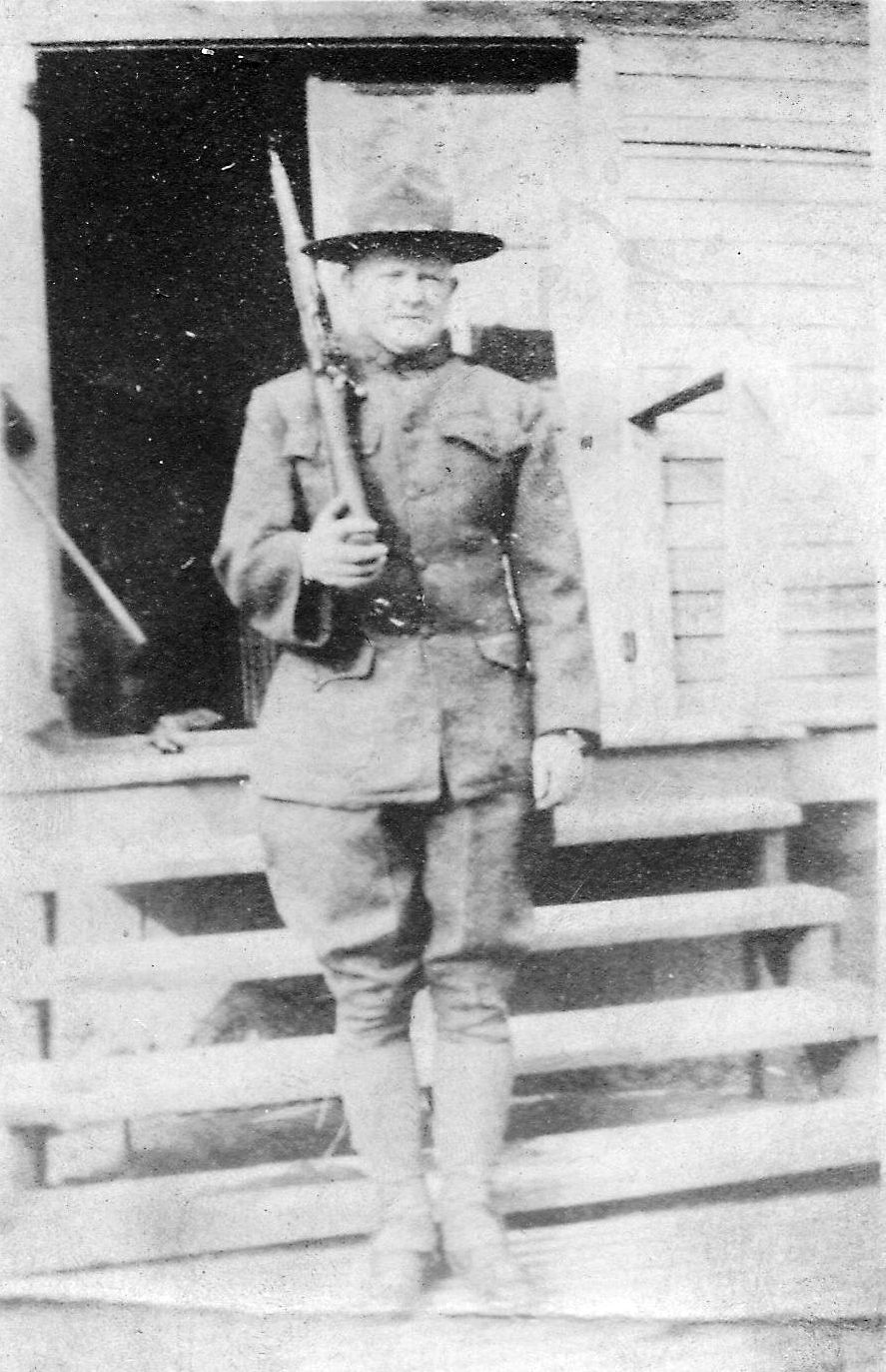
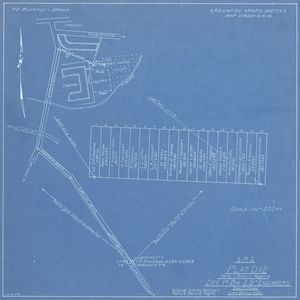


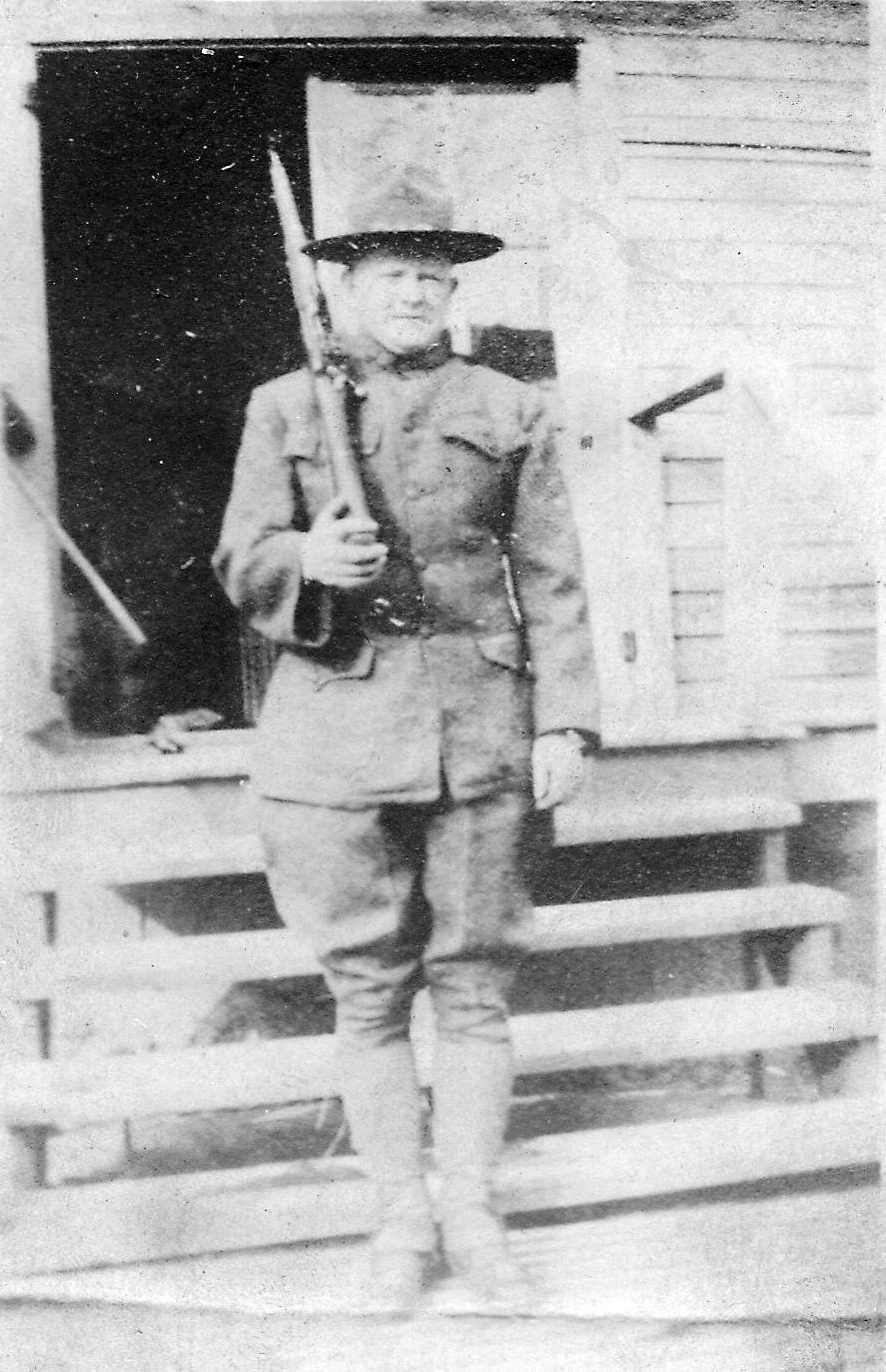

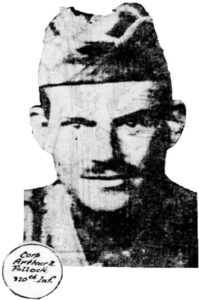

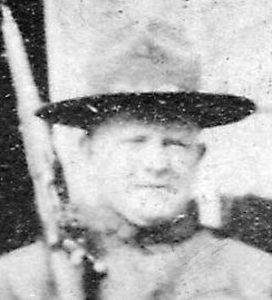
My great aunt arrived at Argentina on 1923 on a ship called Zeelandia that departed from Amsterdam. I wonder if would be the same ship
Great Uncle William G McClellen transported from VA Aug of 1918. WWII. Just discovered this Ship connection to my family.Thanks for this.